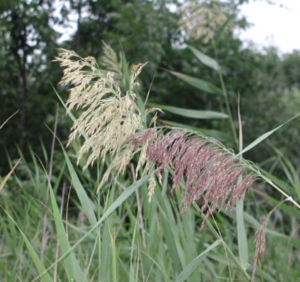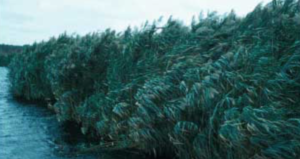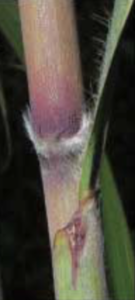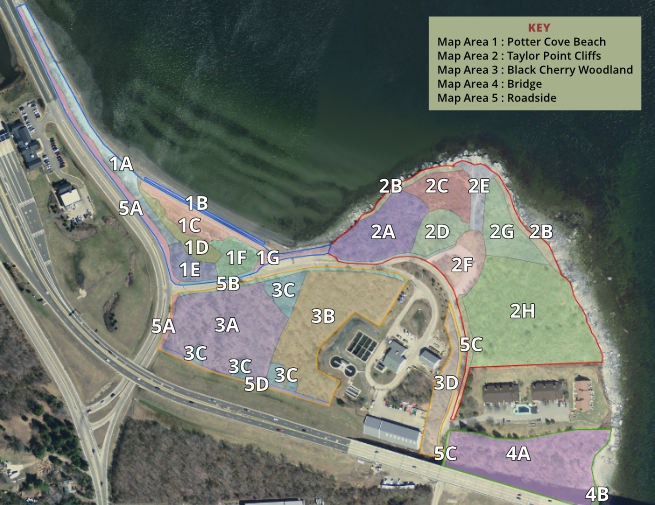Common Name: Common Reed
Specific Name: Phragmites australis
Known Occurrence at Taylor Point:
Map areas: Beach 1C, Beach 1D, Beach 1E
Category: Invasive, Non-Native, Grass

Ecological Considerations:
Phragmites australis is a stout, warm-season, perennial grass that can grow as high as 12 – 15 ft, often extending in vast thick expanses.
The stems of Phragmites are smooth, upright, rigid, and hollow. Its leaves are gray-green, contrasting with long white hairs that grow from the leaf-sheath junction. The inflorescence is light brown to purple in hue, and can reach from 7 to as many as 15 in. long. The seeds of the Common Reed are brown, light weight, and about a third of an inch long. In the fall the plant turns brown. The inflorescences persist throughout the winter.
Phragmites australis can grow in a wide variety of habitats most often in wet and in marshy areas. It can be found in vast colonies along coastal beaches or dunes, along the banks and shores of lakes, streams, rivers and ponds, in ditches, in open disturbed areas, in salt marshes and wet meadows. This plant grows best in fresh water, but also can be found in brackish, acid or alkaline wetlands. It also can form dense, thick walls of vegetation at the interface of upland and wetland habitats.
Problems Posed by this Plant:
Phragmites australis can create problems when it forms expansive monocultures that extend for acres, out-competing native species, and thus lowering species diversity and degrading fish and wildlife habitat.
Native Species Affected by this Plant:
Native wetland plant assemblages.
Factors Affording a Competitive Advantage to this Plant:
Phragmites australis is tolerant of many common urban pollutants, giving it an advantage over native species that are less tolerant of polluting substances and conditions.
Phragmites australis propagates readily by airborne seed dispersal and vegetatively via its vigorous network of rhizomes. The rhizomes can exceed 60 feet in length, can grow more than 6 feet per year and grow easily into new plants when they are split or damaged. They also can penetrate the soil to a depth of more than 6 feet which allows the plant access to low-lying groundwater.
Propagation Mechanisms and Related Issues Affecting Efforts to Remove and/or Eliminate this Plant from Taylor Point:
Common Reed spreads easily and extensively by seed. Mature plants can produce as many as 2,000 seeds a year.
Phragmites australis spreads most aggressively by means of its extensive and aggressive system of horizontal and vertical rhizomes that can persist for 3-6 years. Rhizomes may exceed 60 feet in length, can grow more than 6 feet per year.
Documented Best Removal Practices and Options/Pros and Cons of Various Options:
Cutting has been used successfully to control Phragmites. Hand-pull individual plants spreading up onto the beach, using a shovel or spade as needed.
If a plant is too large to pull, cut with loppers or hedge trimmers or a sickle just before the end of July ( before tassel set ) when most of the food reserves produced that season are removed with the aerial portion of the plant, thus reducing the plant’s vigor. This strategy may eliminate a colony if carried out annually for several years. Be sure to remove cut shoots to prevent their sprouting and forming runners.
Effective control of Phragmites requires attacking each portion of the plant at the specific time within the life cycle that will enable management efforts to slow or stop current and future growth. Effective control strategies ordinarily require multiple treatments using a combination of methods which may include fire, mechanical treatment, and/or water level management.
Control efforts require careful monitoring of wetlands, ditches and moist sites, particularly those that are adjacent to areas which receive nutrient-rich run-off or road salt to identify and address newly emerging growth.
Efforts to burn, mow, disc and dig out plants may actually stimulate growth and spreading.
Extensive management information is available at http://cels.uri.edu/docslink/ceoc/documents/PhragBook.pdf
Suzanne Enser, TPRA CRMC Permit Request Support Document
Case Studies of Removal Efforts, Lessons Learned and Recommendations:
Additional Photos:



Sources cited:
Invasive Plant Atlas of New England
Midwest Invasive Species Information Network
URI College of Environment and Life Sciences
Suzanne Enser, TPRA CRMC Permit Request Support Document
Key Words:
Grasses/Sedges/Rushes;
Common Reed
Phragmites australis
Seed; airborne seed dispersal
Vegetative/rhizomes;
Potter Cove Beach
1-C, 1-D, 1-E
